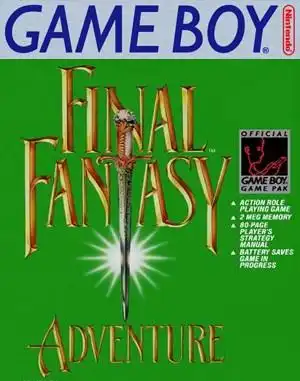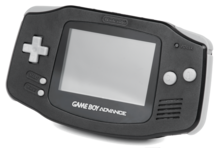Step back in time to 1991. The Game Boy was king, and Square (before the Enix) was crafting magic on both consoles and handhelds. Among their early portable hits was a title that would become a beloved classic, blending action, adventure, and RPG depth in a way few games on the system dared: Final Fantasy Adventure Game Boy.
Known as Seiken Densetsu: Final Fantasy Gaiden in Japan and Mystic Quest in Europe, this game holds a special place in the hearts of many retro gamers. It wasn't just a spin-off; it was the foundational stone of a whole new series – the Mana series!
A Game Boy Legend Was Born
Coming out at a time when action-adventure games like The Legend of Zelda: Link's Awakening were defining the handheld landscape, Final Fantasy Adventure Game Boy carved its own path. It borrowed the top-down perspective and real-time combat of Zelda but layered on character stats, experience points, magic spells, and equipment management familiar to Final Fantasy fans. This hybrid approach felt fresh and ambitious for a Game Boy title, offering a deeper experience than many contemporaries.
It told the story of a young hero, a gladiatorial slave forced to fight for the Dark Lord, who escapes and embarks on a quest tied to the fate of the legendary Mana Tree and a mysterious heroine. The narrative was surprisingly rich and often poignant for its time, featuring memorable characters and unexpected twists.
More Than Just Mashing Buttons
While combat involved swinging your weapon in real-time, the underlying RPG mechanics were crucial. Leveling up allowed you to boost specific stats like HP, power, and stamina, tailoring the hero slightly to your playstyle. Magic spells provided healing and offensive options, powered by MP.
A unique feature was the power gauge, which filled as you attacked. A full gauge allowed for stronger attacks or special weapon abilities, like the axe clearing trees or the chain grappling across gaps. This added a tactical layer beyond simple button mashing. You also often had NPC companions joining you, aiding in battle or solving puzzles. And yes, controversially for a JRPG back then, you could totally whack townspeople (though it didn't achieve much!).
A Quest to Save the Mana Tree
The core plot revolves around preventing the villainous Dark Lord and the sorcerer Julius from seizing control of or destroying the Mana Tree, the source of all life. Your journey takes you across a varied world map, through dungeons, towns, and forests, meeting allies like the heroine, the knight Bogard, and others, while facing off against classic RPG monsters and challenging bosses. It’s a classic tale of good versus evil, with themes of destiny, sacrifice, and the enduring power of hope.
The Quirks of Localization
For many English-speaking players, the Final Fantasy Adventure Game Boy they played was a product of 90s localization, complete with its own unique charm and... quirks.
- Name Game: Perhaps the most famous example is the lack of default names for the hero and heroine. While Japanese materials sometimes used placeholders or semi-official names like "Michael" or "Duke" and "Elena," the English manual showed screenshots with the names "Sumo" and "Fuji." These became the de facto fan names, even influencing later promotional materials, despite having no basis in the Japanese game itself!
- Job vs. Stat: The Japanese version had you choose a "job type" (Warrior, Wizard, etc.) upon leveling up, which then determined your stat boost – a direct nod to the main Final Fantasy series. The English version simplified this, having you choose the stat directly.
- Translation Oddities: The English script is known for numerous grammatical errors, awkward phrasing, and inconsistencies. It often trimmed text, sometimes losing helpful hints. Even boss names had potential hidden references lost in translation, like the vampire boss "Count Lee" (possibly Christopher Lee) becoming just "Kett's" (maybe Vincent Price?) in the English mansion.
These little differences are part of the game's history and add an extra layer of nostalgia and discussion for fans comparing versions.
Where to Find This Gem Today
While tracking down an original Game Boy cartridge is always an option for the purists, Square Enix has made it easier to experience this classic:
- The original Final Fantasy Adventure Game Boy is included in the
Collection of Manareleased for the Nintendo Switch. This is arguably the best way to play the original version legally on modern hardware. - It received a Game Boy Advance remake (
Sword of Mana) and a 3D remake (Adventures of Mana) for Vita and mobile, offering updated takes on the story and gameplay.
Whether you play the original or a remake, the core adventure and its place as the genesis of the Mana series remain intact.
Why We Still Love FFA
Final Fantasy Adventure Game Boy was more than just a handheld RPG; it was a gateway for many players into deeper action-adventure experiences. It proved that complex mechanics and engaging stories were possible on the humble Game Boy. Its blend of action and stats, its memorable music (thanks to Kenji Ito and Nobuo Uematsu), and its pioneering role in the Mana series solidify its status as a true retro classic worth revisiting. It's a nostalgic journey back to a time when portable gaming was just beginning to show its true potential.
FAQ
Q: Is Final Fantasy Adventure actually a Final Fantasy game? A: While it has "Final Fantasy" in the title and was released as a spin-off, it's considered the first game in the separate Mana series (Seiken Densetsu).
Q: How does it compare to The Legend of Zelda: Link's Awakening? A: Both are top-down action-adventure games on Game Boy. FFA adds significant RPG elements like stats, levels, and magic points, while Link's Awakening focuses more on pure action, items, and exploration puzzles.
Q: Are the remakes very different from the original Game Boy version?
A: Yes, Sword of Mana on GBA is a substantial remake with significant changes to story and gameplay mechanics. Adventures of Mana on Vita/Mobile is a 3D remake that stays closer to the original's structure but updates graphics and combat feel. The Collection of Mana on Switch includes the original Game Boy version.
Q: Why are the hero and heroine often called Sumo and Fuji by fans? A: These names appeared as placeholders in screenshots in the English Game Boy manual, leading fans to adopt them as the unofficial default names.


